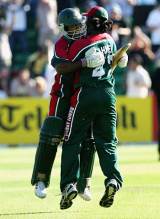
|

The moment of victory: Mohmmad Rafique and Aftab Ahmed celebrate on behalf of their nation
© Getty Images
|
|
For Rupert Brooke, some corner of a foreign field would be forever England. For millions and millions of ecstatic Bangladeshis, a patch of green in Wales will always have similar associations - the venue where a nation overcame enormous odds and the sneering pessimism of many to give us a joyful reminder of the very essence of sporting endeavour.
Claude McKay, a Jamaican who was one of the pioneers of the struggle for self-respect among people of colour, once wrote: "Nations, like plants and human beings, grow. And if the development is thwarted they are dwarfed and overshadowed."
Bangladesh, one of the world's younger nations, had a tumultuous birth, a difficult adolescence and is still searching for maturity in young adulthood. Its cricket has mirrored its society, but has already been branded a failure despite barely having reached adolescence. Obsessed as sport has become with the business of winning and losing, many of us have lost sight of what merely taking part can mean to those who don't start with a silver spoon.
Defeat can damage the spirit, while repeated failure, such as Bangladesh's cricketers have grown accustomed to, can crush it. Sometimes, it needs something out of the ordinary - a pint-sized Aftab Ahmed thumping a demonic-looking Jason Gillespie over midwicket for six - to make us believe again that there are few boundaries for the human spirit. Once Mohammad Ashraful, Aftab and friends discarded the scabs of past failures and embraced the here and now, they achieved what few teams have managed against Australia in recent seasons, a comprehensive one-day victory.
Most of the great upsets in one-day cricket history - India in the World Cup final of '83, Kenya against West Indies (1996) and Bangladesh against Pakistan (1999) - had been achieved while defending modest totals. Bangladesh did it the hard way at Sophia Gardens, withstanding the pressure in pursuit of a target that was certainly not insignificant. Ricky Ponting may have erred in deciding to bat first, but there was nothing fortuitous or dodgy about Bangladesh's victory. Right from the first spells bowled by Mashrafe Mortaza and Tapash Baisya to the coup de grace so thrillingly applied by Aftab, this was as good as it gets, a victory earned by inspiration and perspiration, rather than one gifted away by complacent or corrupt opposition.

|

Mohammad Ashraful's moment of fulfilment © Getty Images
|
|
Indians who remember the heady days of 1983, when a nation's cricket truly came of age, might hark back to a March night (Indian time) in Berbice, Guyana, when Sunil Gavaskar (90) and Kapil Dev (72 from just 38 balls) propelled the team to 282 for 5 from just 47 overs. Despite a characteristically savage 64 from Viv Richards, it was enough to seal victory by 27 runs against the most formidable side that the world had ever known.
For the outside world, it was just an upset victory, but for Indians, it was a small glimpse into a future where they would no longer be second-raters and habitual whipping boys. Having lost 27 of their 38 ODIs prior to that one - three of the wins had come against lowly Sri Lanka - the heroes of Berbice would move on to England two months later and author the most eventful chapter in the country's sporting history. The Albion Sports Complex lost its place on cricket's map two decades ago, but for Indian cricket aficionados, it will always have magical connotations.
Duncan Fletcher, currently engaged in an attempt to wrest back the Ashes after nearly two decades of Australian dominance, could also tell you a thing or two about epochal matches. In the autumn of his career, with Zimbabwe playing their first one-day international, he had the sort of day that schoolboys dream about, scoring an unbeaten 69 and picking up 4 for 42 as an Australian team on the wane were beaten by 13 runs. That result, as much as the Eddo Brandes demolition job against England at Albury nine years later, fast-tracked Zimbabwe to Test status.
Bangladesh already dine at the top table, but ever since a deplorable showing at the 2003 World Cup, there have been many who wanted their meal ticket taken away from them. The clamour grew louder after the pasting they received at English hands in the Test series, criticism that conveniently ignored India's 42 all out (1974) and West Indies' capitulation for just 54 (2000) on previous English excursions. While Bangladesh's cluelessness at Test level is no figment of the critics' imagination, victories like the one in Cardiff have shown that there is a core group of young players capable of transforming a gloomy present into a bright future.
Those who have been to Bangladesh will tell you that cricket is far more than just a game for the people. Like football for the kid in a Rio favela, or basketball for a child of America's most violent ghettos, cricket is a harbinger of hope for the average Bangladeshi. And while legends and journalists are entitled to their beliefs about Bangladesh's status in cricket's grand scheme, we may be guilty of taking them too seriously. After all, which sadist would put the opinion of a few elitists over the happiness of over 130 million people?
Dileep Premachandran is assistant editor of Cricinfo



